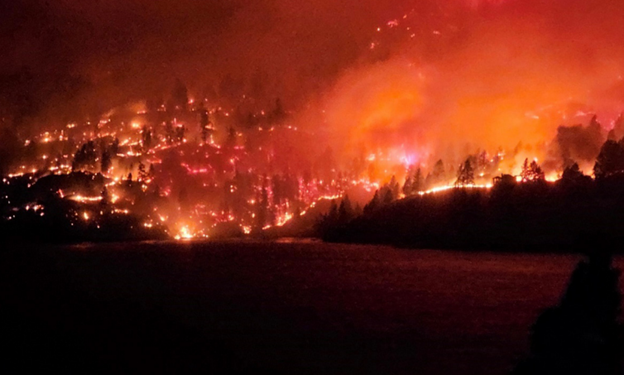
In a season that stands out for unprecedented wildfire activity, the 2023 Grouse Complex of wildfires was one of the most destructive wildland-urban fire events the Okanagan region has ever experienced.
A wildfire complex usually has two or more fires burning simultaneously in close proximity. It is typically assigned an incident management team, reflecting the increased danger that multiple fires may pose to nearby communities. The Grouse Complex of wildfire included the McDougall Creek, Clarke Creek and Walroy Lake wildfires.
Before it was over, 15,076 hectares were consumed, 30,700 people were evacuated, 303 structures burned and insured losses exceeded $480 million. The impact on those affected by these fires, especially those who lost their homes, is incalculable.
To better understand how wildland-urban fires move into and through communities, the BC FireSmart Committee and the Institute for Catastrophic Loss Reduction enlisted FPInnovations to conduct a post-fire analysis of the Grouse Complex.
The study’s key objectives include an analysis of how the fire spread and what factors contributed to a structure’s ignition or survival.
Background: weather, fuel and topography set the stage
First reported on August 15, the McDougall Creek wildfire grew to a high intensity, Rank 6 crown fire by August 17 due to a combination of very dry fuels, rugged terrain and strong winds. Long-term drought conditions, several weeks of high temperatures, low relative humidity (RH) values and minimal precipitation in the weeks before, set the stage for fast-spreading, high-intensity crown fires, which spread through the forest canopy.
An already challenging situation was made worse when an unusually dry, fast-moving cold front stalled east of Kelowna. This weather event resulted in a towering convection column that lofted embers thousands of metres ahead of the main fire front, producing a massive number of spot fires. Embers from the McDougall Creek wildfire travelled over 2.5 kilometres across Okanagan Lake to ignite the Walroy Lake and Clarke Creek wildfires.
Some of the key findings of the study revealed that:
- Fire entered neighbourhoods almost exclusively via embers, rather than direct flame contact, quickly shifting from a wildfire to several urban fires burning simultaneously.
- The presence of flammable materials within 10 metres of structures emerged as one of the most significant factors influencing whether a structure was damaged by the fire or survived.
- Yards containing cedars, junipers, unpruned coniferous trees and an abundance of other easily ignitable materials were particularly problematic.
- Homes situated on steep slopes, often with overhanging decks above flammable vegetation, were particularly vulnerable.
- Fire entered many homes due to the proximity of flammable materials and vegetation and the failure of combustible soffits, allowing the fire to spread into attic spaces.
- Timely action by fire suppression personnel to remove or douse combustible materials, saved neighbouring structures.
Recommendations for residents based on case study findings:
- Remove or relocate combustible items (e.g. firewood, scrap lumber, propane tanks, fuel cans, plastic patio furniture and recreation equipment, etc.) within 10 metres of a structure.
- Establish a 1.5 metre zone around structures free of all combustible material (vegetation and non-vegetation).
- Manage coniferous vegetation from 1.5 to 10 metres from a structure according to FireSmart guidelines using spacing, thinning, pruning and planting leafy (deciduous) species.
- Remove, reduce or replace combustible vegetation on slopes immediately below structures.
- Construct decks from fire-resistant materials, keep them well-maintained and remove combustible items on and under decks. If deck replacement is not immediately possible, manage combustibles on and below the deck.
- Plant low-flammability deciduous tree species 10 to 30 metres from structures.
- Review the FireSmart BC Begins at Home Guide for detailed instructions on how to keep your home safe.
- Visit the FireSmart BC Landscaping Hub for design tips and plant recommendations.
Recommendations for governments and industry:
- Develop a cold front categorization system to enhance preparedness and response strategies.
- Investigate new soffit technology and materials to improve fire resistance.
- Development policies and practices should strive for better integration of established FireSmart principles for land use and planning including:
- Limiting development in high wildfire risk areas.
- Expand Wildfire Development Permit Areas, aligning their guidelines across jurisdictions and enhancing enforcement of regulations.
- Increase zoning bylaw setbacks in heavily forested and rural areas.
- Introduce or enhance landscaping and fencing regulations to establish non-combustible zones around structures.
For a more detailed analysis, we recommend reading the entire case study:
